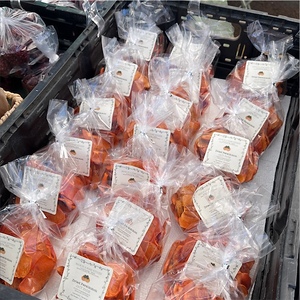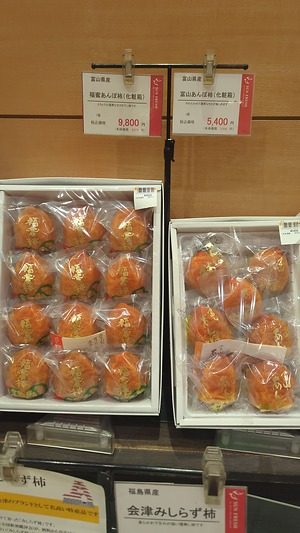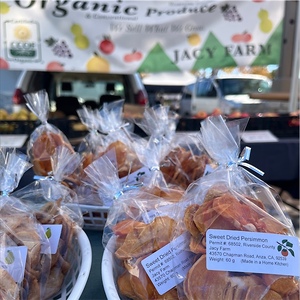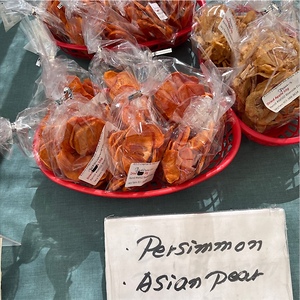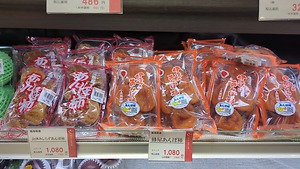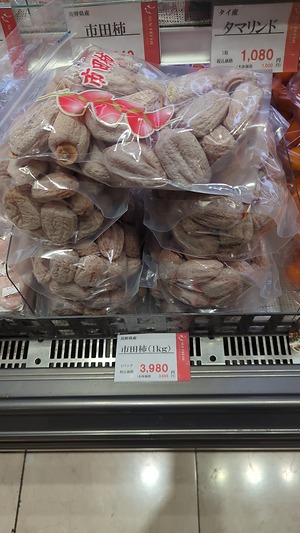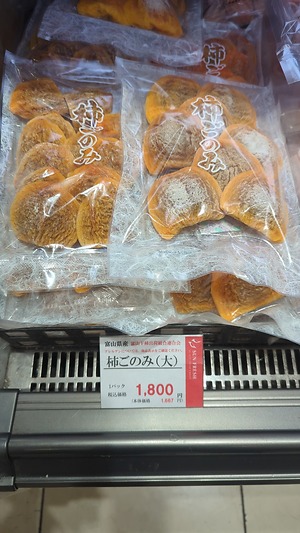


Dried Persimmons
Estimated Inventory, 2.5 lbs : 0
Description/Taste
Dried Persimmons vary in size and shape, depending on the specific variety, and generally have a creased and folded, oval shape, tapering slightly at the tip, to being round, flat, and having a disc-like appearance. Regardless of the variety and shape of the fruits, Dried Persimmons have a dusty brown-orange to golden-orange hue and a dehydrated, lightly wrinkled, textured surface. The flesh is also orange and develops a chewy, sticky, tender, and soft consistency with concentrated sugars, increasing the fruit’s overall sweetness. When Dried Persimmons are ready for consumption, they will develop a light white coating of sugar on the surface. This powdery coating is edible and is a sign of the fruit’s sweetness. Dried Persimmons have a concentrated, sweet, and fruity flavor with honeyed nuances of brown sugar and cinnamon.
Seasons/Availability
Dried Persimmons are available year-round. Fresh persimmons are harvested in the fall and winter to produce the dried fruits.
Current Facts
Dried Persimmons, botanically classified as Diospyros kaki, are preserved versions of fresh persimmon fruits belonging to the Ebenaceae family. Persimmons grow on deciduous trees reaching 10 to 18 meters in height and are native to East Asia, where the fruits have been utilized in culinary, medicinal, and ornamental practices for hundreds of years. Dried Persimmons have been prepared since ancient times and are traditionally made from astringent persimmon varieties. There are several types of persimmons used for dried purposes throughout China, Vietnam, Korea, and Japan, the central production regions of the fruits. In China, Korea, and Vietnam, Dried Persimmons are developed by dehydrating the fruits in wire baskets, creating a squished disc shape. These types of Dried Persimmons are also known as Gotgam in Korean and Shibing in Chinese and are generally cheaper than the well-known persimmons produced in Japan. Hoshigaki, or Dried Japanese Persimmons, are developed through a labor-intensive process of peeling, hang drying, and hand-massaging the fruits daily to create a slightly different flavor and texture. Japanese Dried Persimmons are considered rare due to their limited quantities, and their luxury price tags reflect the amount of time and energy that growers put into creating the dried fruits. Dried Persimmons are consumed out of hand and are also favored as a sweetener for baked goods, beverages, and appetizers.
Nutritional Value
Dried Persimmons are a good source of vitamin A to maintain healthy organ functioning and fiber to regulate the digestive tract. The fruits also provide small amounts of vitamin C to strengthen the immune system, potassium to balance fluid levels within the body, and calcium to protect bones and teeth. In addition to vitamins and minerals, Dried Persimmons develop a concentrated amount of sugar, including the white coating on the surface of the fruit. This sugar coating is used in folk medicine as a natural remedy for throat pain and coughs.
Applications
Dried Persimmons have a sugary-sweet flavor and chewy, sticky texture well suited for a variety of appetizers, desserts, and snacks. The preserved fruits can be sliced into bite-sized pieces and consumed straight, out of hand, and portions of the flesh are popularly displayed on appetizer plates, cheeseboards, or served with afternoon tea. Dried Persimmons can also be chopped and tossed into salads, incorporated into sauces and purees, flattened and rolled with nuts inside as a crunchy filling, finely chopped and mixed into biscotti and scones, or folded into other desserts. In Korea, Dried Persimmons are stuffed with pine nuts and served with sweet confections such as suksil-gwa. The fruits are also simmered into sujonggwa, a ginger-cinnamon punch traditionally served over holidays. In Japan, there is another type of Dried Persimmon known as anpo-gaki or half-dried persimmon. This type of preserved fruit is dried for a shorter period of time and then sprayed with sulfur to develop a soft, juicy, and sticky, jam-like texture. Anpo-gaki is customarily served in small tea sandwiches with soymilk cream. The persimmons are also used to flavor tiramisu. Beyond culinary dishes, Dried Persimmons are used throughout Asia to make wine and tea. Dried Persimmons pair well with nuts such as walnuts, almonds, and pistachios, spices including ginger, nutmeg, cinnamon, and allspice, honey, caramel, maple syrup, vanilla, and fruits such as pears, oranges, pomegranates, and apples. Whole, Dried Persimmons should be stored at room temperature in a sealed container in a cool and dark location, where they will keep for 6 to 12 months. The fruits can also be wrapped tightly in plastic wrap and stored in the freezer for 12 to 18 months.
Ethnic/Cultural Info
Dried Persimmons are produced throughout East Asia, but in Japan, the fruits are dried using a traditional process that has been practiced for hundreds of years. The dried fruits are known as hoshigaki, a combination of “hoshi,” meaning “dry” and “kaki,” meaning “persimmon,” and the labor-intensive practice was initially used as a method of food preservation for the winter season, utilizing solely hachiya persimmons. This persimmon variety is known for having astringent, inedible flesh until it completely softens, but the drying process allows growers to use the astringent fruits when young before the fresh fruits ripen. Astringent persimmons contain a high sugar content, and once the tannins are removed through dehydration, the dried persimmons develop a concentrated, sugary taste believed to be approximately 1.5 times sweeter than fresh persimmons. Hachiya persimmons are peeled, hung from a string, and left to dry for 4 to 6 weeks. As the fruits are drying, they must be hand massaged to soften the flesh, and over time, they develop a soft, dense, sticky, and chewy consistency distinct from dried persimmons made in China, Vietnam, or Korea. Hoshigaki also produces a white bloom on the surface, a natural coating of sugar, and this bloom is one of the traits that signals the dried fruits are ready for consumption. Hoshigaki is commonly sliced and consumed as a sweet snack, or they are used to flavor wagashi, Japanese sweets served with green tea. The dried fruits are also used as decorations during New Year celebrations. Hoshigaki can be seen strung in windows, along covered porches, and in well-ventilated rooms, and the fruits are a symbol of longevity and good luck. Some Japanese families also gift hoshigaki to friends and family as a gesture of goodwill. Despite the dried fruit's popularity, only a small amount of hoshigaki is produced each year, increasing the demand for the luxury dried fruit.
Geography/History
Dried Persimmons are made from varieties of Diospyros kaki, also known as Asian or Oriental persimmons, native to China, where they have been cultivated for centuries. The astringent fruits were given as gifts to the imperial court in China during the Han Dynasty, 202 BCE to 220 CE, and were eventually spread to Korea and Japan sometime before the 7th century. The first recorded documentation of Dried Persimmons in Japan was in a historical text written during the Heian Era, sometime from 794 to 1185 CE. By the 10th century, Dried Persimmons were extensively cultivated throughout East Asia. The preserved fruits were also introduced to the United States in 1870 when the USDA planted persimmon trees in California, Georgia, and Florida. As Japanese and Chinese immigrants settled into the San Joaquin Valley and Northern California, they also brought the traditional practices of drying persimmons. Today Dried Persimmons are widely grown throughout East Asia in Japan, China, Korea, and Vietnam and are primarily found through fresh markets and local growers. The fruits are also cultivated in California and are sold through farmer’s markets and distributors as a limited release.
Recipe Ideas
Recipes that include Dried Persimmons. One







